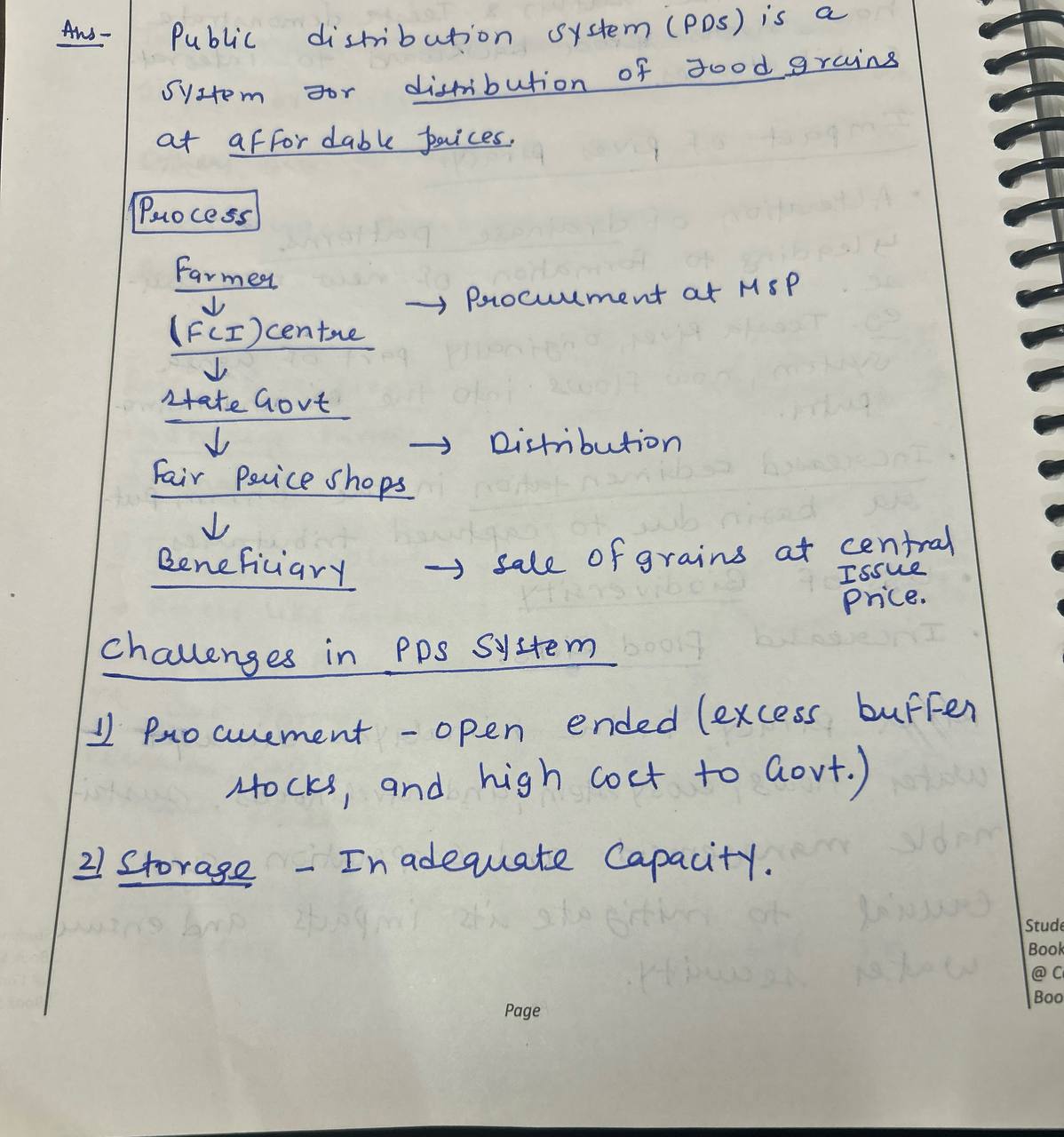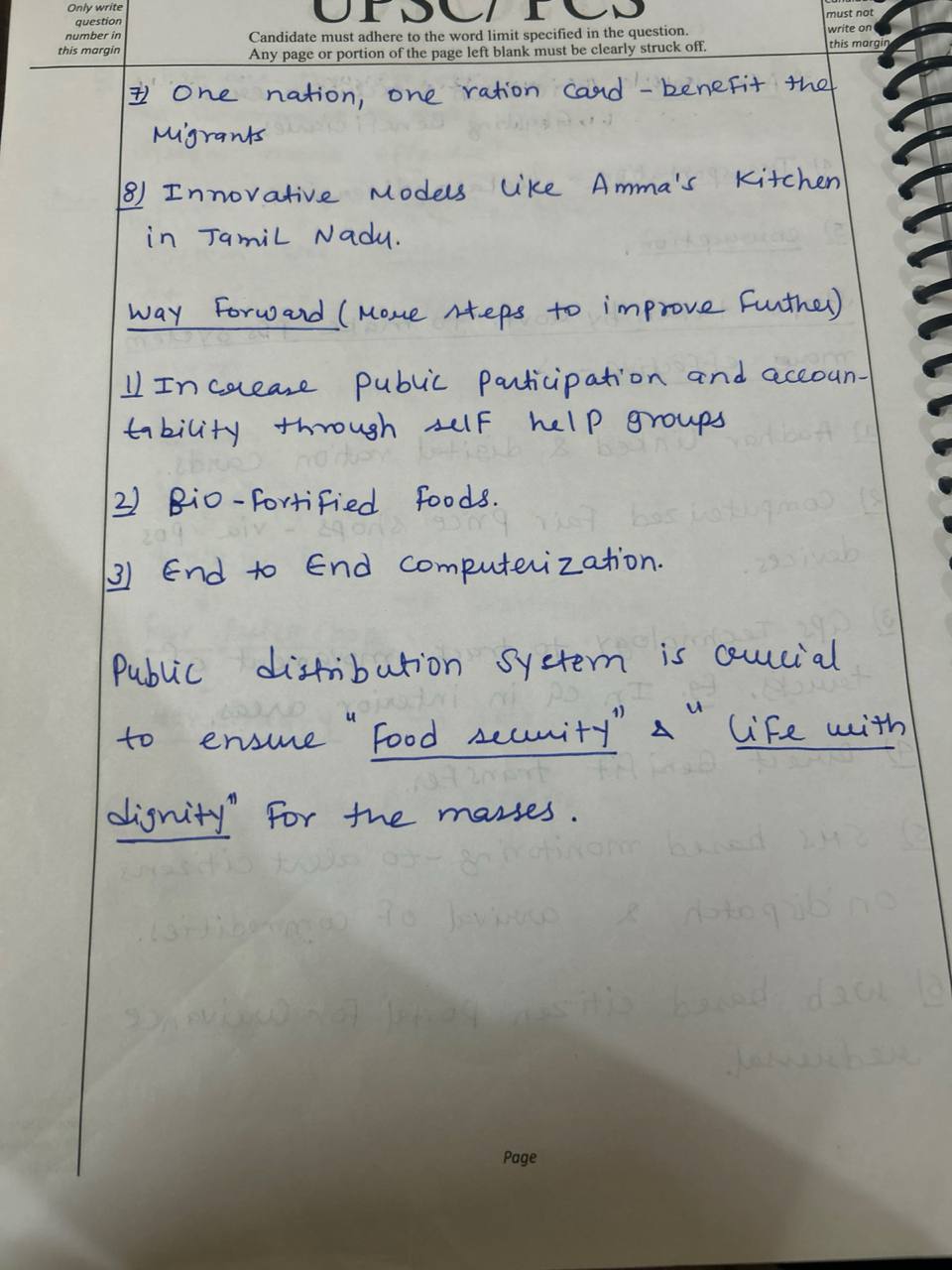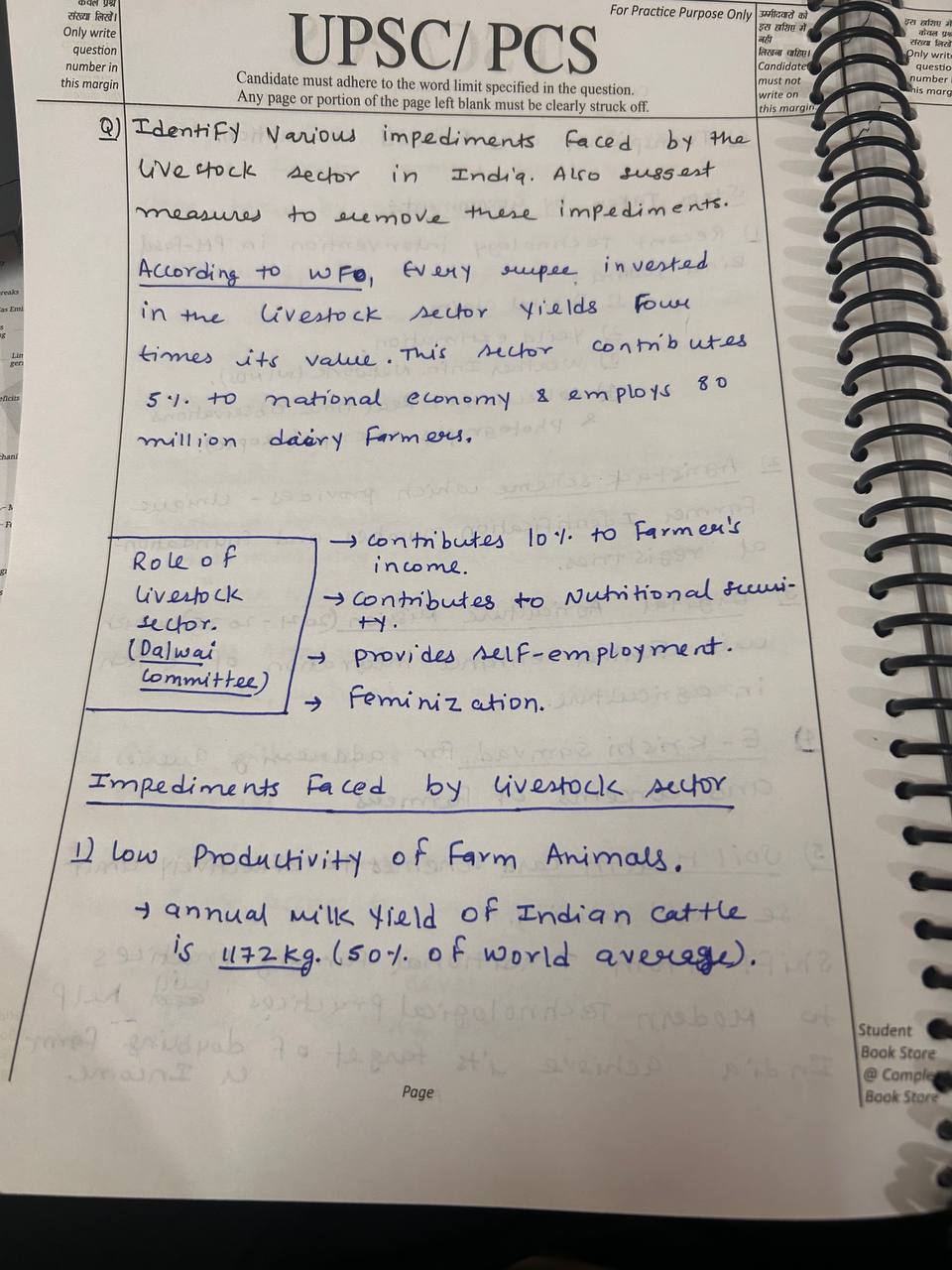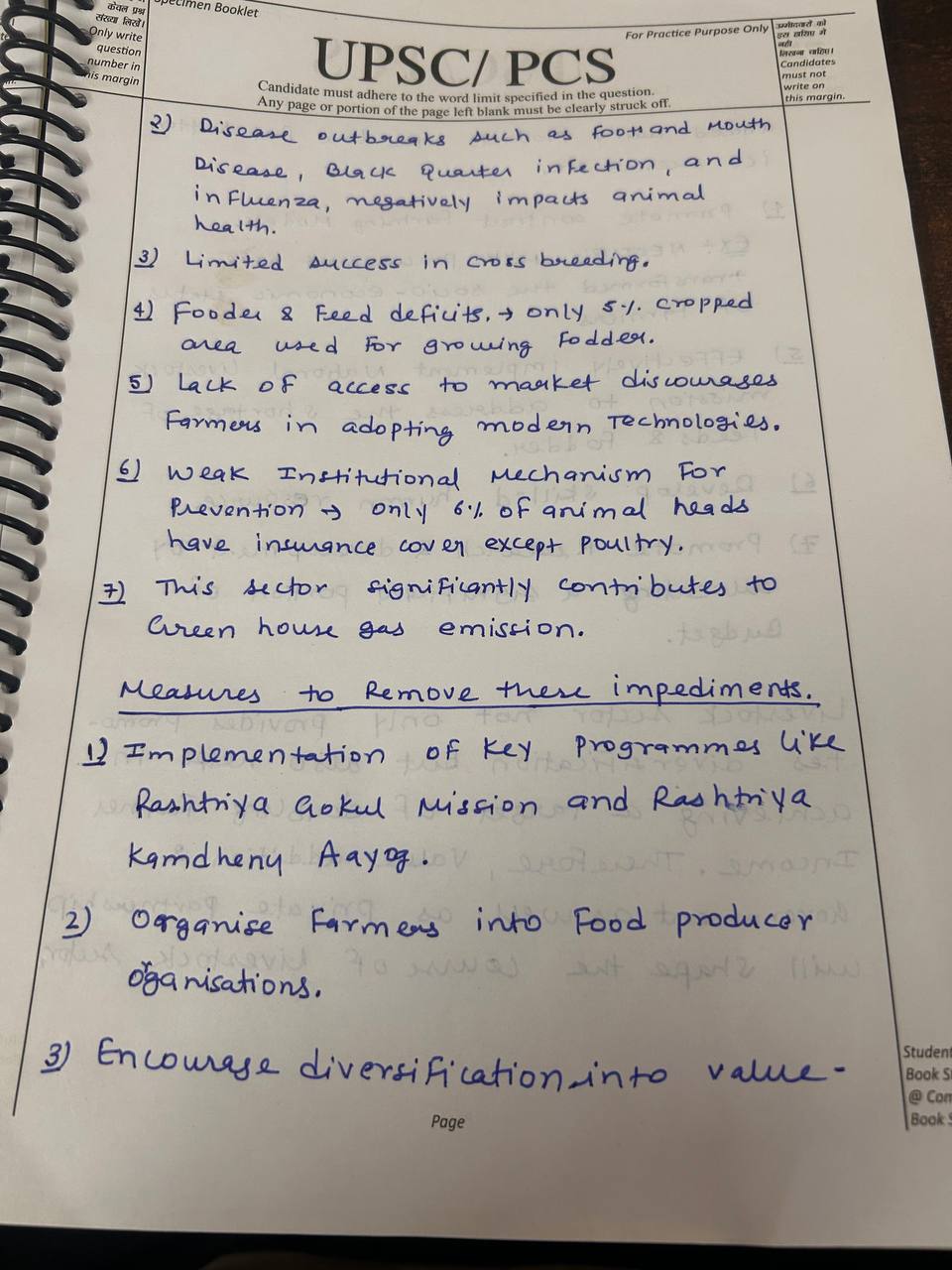List the several obstacles that India’s cattle industry faces. Additionally, recommend actions to get rid of these obstacles.(Answer in 200 words)
- Recent Questions
- Most Answered
- Answers
- No Answers
- Most Visited
- Most Voted
- Random
- Bump Question
- New Questions
- Sticky Questions
- Polls
- Followed Questions
- Favorite Questions
- Recent Questions With Time
- Most Answered With Time
- Answers With Time
- No Answers With Time
- Most Visited With Time
- Most Voted With Time
- Random With Time
- Bump Question With Time
- New Questions With Time
- Sticky Questions With Time
- Polls With Time
- Followed Questions With Time
- Favorite Questions With Time
Mains Answer Writing Latest Questions
List the problems that India has with managing and storing food grains. Mention the actions the government has done to resolve this as well.
Roadmap for Answer Writing 1. Introduction Context: Briefly introduce the NHM, established in 2005 by the Ministry of Agriculture and Farmers’ Welfare, aimed at developing horticulture. Significance: Highlight the importance of NHM in enhancing agricultural productivity and farmer livelihood. 2. Role of NHM in ...
-
Model Answer Introduction The National Horticulture Mission (NHM) was launched in 2005 by the Ministry of Agriculture and Farmers’ Welfare to enhance the production and productivity of horticultural crops in India. Its primary objective is to develop horticulture to its maximum potential across variRead more
Model Answer
Introduction
The National Horticulture Mission (NHM) was launched in 2005 by the Ministry of Agriculture and Farmers’ Welfare to enhance the production and productivity of horticultural crops in India. Its primary objective is to develop horticulture to its maximum potential across various states.
Role of NHM in Boosting Productivity and Income
- Integrated Development of Horticulture (IDH): NHM promotes a holistic approach by integrating production, processing, and marketing activities, which enhances overall productivity.
- Modernizing Production: The mission encourages the use of advanced technologies, natural fertilizers, and eco-friendly pesticides. For instance, the introduction of harvester machines has improved efficiency in harvesting crops like coffee.
- Farmer Aggregation: NHM supports the formation of farmer groups such as Farmer Interest Groups (FIGs) and Farmer Producer Organizations (FPOs), which help in achieving economies of scale.
- Governance and Market Access: Specific boards, such as coffee and cashew boards, have been established to streamline production and marketing processes, providing farmers with better access to markets.
- Capacity Building: NHM facilitates training programs that transfer technology and knowledge from research institutions to farmers, focusing on production, post-harvest management, and marketing strategies.
Success in Increasing Farmers’ Income
The NHM has significantly impacted farmers’ income through various measures:
- Production Growth: The production of fruits increased from 43.5 million tonnes in 2004-05 to 107.7 million tonnes in 2021-22, demonstrating substantial growth in horticultural output.
- Area Expansion: The area under horticulture has grown at an average rate of 3% per annum, with annual production increasing at an average rate of 7.0% per annum.
- Diversification and Alternative Income: NHM encourages the cultivation of high-value crops alongside traditional crops, providing farmers with additional income sources.
- Market Opportunities: The mission has created new market opportunities for horticultural products, contributing to reduced rural unemployment over the past two decades.
Conclusion
The NHM has played a crucial role in transforming horticulture in India, leading to increased production, productivity, and farmer income. However, challenges such as inadequate infrastructure and market access remain, necessitating ongoing efforts to stabilize and enhance farmers’ income.
See less
Roadmap for Answer Writing Introduction Overview of India’s Agricultural Economy Highlight the significance of agriculture in India and its role in providing livelihoods. State the impact of agricultural revolutions post-independence. Body Types of Agricultural Revolutions After Independence Green Revolution Definition: Introduction of high-yielding varieties (HYVs) of seeds, fertilizers, ...
-
Model Answer Introduction India's economy has a strong agricultural foundation, with a significant portion of the population relying on agriculture for their livelihoods. Post-independence, various agricultural revolutions supported by the government have transformed the sector, enhancing productiviRead more
Model Answer
Introduction
India’s economy has a strong agricultural foundation, with a significant portion of the population relying on agriculture for their livelihoods. Post-independence, various agricultural revolutions supported by the government have transformed the sector, enhancing productivity and food security.
Various Types of Agricultural Revolutions After Independence
- Green Revolution
- Introduced in the 1960s, this revolution focused on high-yielding varieties (HYVs) of seeds, fertilizers, and pesticides, leading to a significant increase in food grain production, particularly wheat.
- Fact: Wheat production rose from 12 million tons in 1965 to over 25 million tons by the early 1970s (source: Indian Council of Agricultural Research).
- White Revolution
- Launched in 1970 through Operation Flood, this initiative transformed India into the world’s largest milk producer by improving breeding techniques, fodder quality, and veterinary services.
- Fact: India now accounts for approximately 17% of global milk production (source: National Dairy Development Board).
- Blue Revolution
- Focused on the fisheries sector, this revolution led to increased fish production through better management practices in aquaculture and marine fisheries.
- Fact: Fish production in India increased from 0.75 million tons in 1950-51 to over 13 million tons by 2020 (source: Department of Fisheries).
- Other Revolutions
- Yellow Revolution: Focused on oilseed production.
- Golden Fibre Revolution: Pertained to jute production.
- Golden Revolution: Related to horticulture.
- Silver Fibre Revolution: Focused on cotton.
- Red Revolution: Concerned with meat production.
Significance of These Revolutions
- Self-Sufficiency
- The Green Revolution made India self-sufficient in food grains, while the White Revolution transformed it into a leading milk producer.
- Reduced Poverty
- Agricultural innovations have generated rural income opportunities, lifting millions out of poverty and stabilizing food prices for consumers.
- Nutritional Security
- Increased milk availability has improved nutritional security, with per capita milk consumption reaching 337 grams/day.
- Diversified Income Sources
- Farmers diversified into livestock and poultry, helping mitigate agricultural uncertainties and enhancing financial stability.
Conclusion
To sustain the progress made through these revolutions and ensure long-term food security, the Indian government has initiated the Rainbow Revolution, focusing on holistic agricultural development. Continued efforts in this direction will further strengthen the agricultural sector and improve the livelihoods of millions.
See less - Green Revolution
Roadmap for Answer Writing Introduction Begin with a brief context of the vulnerability of Indian agriculture. Mention factors like dependency on monsoon, extreme weather conditions, and the ...
-
Model Answer Introduction Indian agriculture is excessively dependent on monsoons, with only 35% of the total area under cultivation being irrigated as of 2010, according to the World Bank. This heavy reliance on monsoon rains, coupled with fluctuations and natural calamities such as droughts, floodRead more
Model Answer
Introduction
Indian agriculture is excessively dependent on monsoons, with only 35% of the total area under cultivation being irrigated as of 2010, according to the World Bank. This heavy reliance on monsoon rains, coupled with fluctuations and natural calamities such as droughts, floods, and hailstorms, has severely impacted farmers’ livelihoods. Even in years of abundant production, farmers often face price volatility, making crop insurance essential for stabilizing their income and production.
Need for Crop Insurance
- Protection Against Crop Failure: Crop insurance safeguards farmers from losses due to crop failures, ensuring stability in their income.
- Yield Protection: It provides coverage against reduced production and post-harvest losses, helping farmers recover from adverse conditions.
- Revenue Protection: The insurance offers a safety net against price fluctuations, guaranteeing a minimum assured income during bumper harvests when prices may crash.
- Reduced Government Expenditure: By minimizing the need for reactive relief measures during natural calamities, crop insurance serves as a proactive financial tool.
- Encouragement of Investment: With reduced risk, farmers are more likely to invest in innovative agricultural practices, enhancing productivity.
Recognizing these needs, the government introduced the Pradhan Mantri Fasal Bima Yojana (PMFBY) to replace the outdated National Agriculture Insurance Scheme (NAIS) and Modified National Agricultural Insurance Scheme (MNIAS), aiming to cover 47% of farmers within a year.
Salient Features of PMFBY
- Comprehensive Coverage: PMFBY covers Rabi, Kharif, and horticultural crops, including protection against various natural calamities and post-harvest losses.
- Affordable Premium Rates: The scheme offers a uniform premium rate of 2% for Kharif crops, 1.5% for Rabi crops, and 5% for commercial and horticultural crops, with the government subsidizing the remaining amount.
- Technological Integration: The use of remote sensing, smartphones, and drones facilitates quick assessment of crop losses.
- Area Approach Implementation: The scheme is executed on an area basis, focusing on homogenous crop cultivation and risk assessment at the village level.
- Optional Enrollment: Since 2020, enrollment in the scheme has been made optional for all farmers, moving away from the previous mandatory requirement for loanee farmers.
Conclusion
The increasing frequency of climate-induced extreme weather events and market fluctuations has heightened the distress among farmers, underscoring the urgent need for effective crop insurance. The PMFBY represents a significant step towards safeguarding farmers’ interests and promoting sustainable agricultural practices in India.
See less
Roadmap for Answer Writing Introduction Define APMCs Briefly explain Agricultural Produce Market Committees (APMCs) and their purpose in regulating agricultural markets under state acts. Thesis Statement Introduce the viewpoint that APMCs may hinder agricultural development and contribute to food inflation, setting the stage for a ...
-
Model Answer Introduction Agricultural Produce Market Committees (APMCs) were established under state acts in the 1950s to enhance transparency and eliminate trader discretion in agricultural markets. These committees regulate the sale of notified agricultural products, which vary by state and typicRead more
Model Answer
Introduction
Agricultural Produce Market Committees (APMCs) were established under state acts in the 1950s to enhance transparency and eliminate trader discretion in agricultural markets. These committees regulate the sale of notified agricultural products, which vary by state and typically include essential cereals and vegetables. However, there is a growing perception that APMCs have impeded agricultural development and contributed to food inflation in India.
Body
Monopoly and Cartelization
APMCs often create a monopoly that restricts farmers’ access to better customers, thereby reducing their profitability. Agents within APMCs frequently form cartels, manipulating prices by restraining competitive bidding. This leads to produce being sold at artificially low prices, while hoarding by agents exacerbates food inflation, particularly for perishable goods, which farmers cannot store or bargain over effectively.
Entry Barriers and Costs
The high license fees and additional costs such as commissions, marketing fees, and APMC cess further burden farmers. These financial barriers not only hinder agricultural growth but also increase the risk of food inflation by raising the overall cost of produce.
Conflict of Interest
APMCs operate with a dual role as both regulators and market participants, which creates a conflict of interest. This duality undermines their regulatory function, allowing vested interests to manipulate market conditions to their advantage.
Other Manipulations
Agents often engage in practices that disadvantage farmers, such as withholding payment slips or blocking payments for dubious reasons. This lack of transparency hampers farmers’ ability to secure loans and invest in future crops, leading to stagnation in agricultural productivity.
Conclusion
While the central government introduced the Model APMC Act in 2003 to address these issues, its implementation has been inconsistent across states. Some states, like Bihar and Delhi, have abolished APMCs, but this has not significantly improved agricultural conditions or reduced food inflation. The challenges of food inflation stem from a combination of structural issues, including inadequate supply chains and high wastage, with APMCs being a contributing factor that requires reform.
See less
Roadmap for Answer Writing: Introduction Define urban agriculture concisely, explaining it as the practice of growing food and non-food items within urban and peri-urban areas. Provide a brief overview of its significance in modern cities, citing how urban agriculture contributes to local food ...
-
Best Answer
Model Answer Definition of Urban Agriculture Urban agriculture involves the cultivation of food and non-food products within urban and peri-urban spaces, which can include activities such as vertical farming, rooftop gardens, aquaponics, and urban beekeeping. Globally, urban agriculture contributesRead more
Model Answer
Definition of Urban Agriculture
Urban agriculture involves the cultivation of food and non-food products within urban and peri-urban spaces, which can include activities such as vertical farming, rooftop gardens, aquaponics, and urban beekeeping. Globally, urban agriculture contributes approximately 5-10% of legumes, vegetables, and tubers and up to 20% of all food supply, providing locally grown produce to city residents.Benefits of Urban Agriculture
- Health and Nutrition Benefits
Urban agriculture reduces the supply chain by eliminating intermediaries, which helps maintain food nutrients and reduce food damage during transport. This local supply of fresh produce can reduce reliance on processed foods, potentially lowering the risk of lifestyle diseases related to poor diet. Source: FAO, Urban Agriculture Report 2021. - Economic Benefits
By shortening the distance between farm and consumer, urban agriculture strengthens the resilience of the food supply chain and reduces dependency on factors like oil prices and agricultural imports. It also supports job creation through the establishment of urban farming businesses, providing employment opportunities within local communities. Source: World Bank, Agriculture in Cities Review. - Environmental Benefits
Urban agriculture supports urban biodiversity, improves air quality, and can mitigate the urban heat island effect. It helps reduce carbon emissions by minimizing transportation needs and packaging. Additionally, green spaces in cities can act as carbon sinks and reduce stormwater runoff, particularly through techniques like aquaponics and street landscaping. Source: UN Environment Programme. - Waste Management
Organic waste can be composted for use in urban farms, reducing landfill needs and contributing to sustainable waste management. Source: Global Waste Management Outlook, UNEP.
Challenges of Urban Agriculture
- Limited Access and High Costs
Urban farming often requires costly private land or rooftop spaces, making it financially exclusive and limiting broader access. Source: Urban Land Institute Report. - Water Demand
Urban agriculture can strain city water resources since it often relies on potable municipal water, contributing to potential shortages. Source: World Resources Institute. - Lack of Recognition
Many governments lack formal policies supporting urban agriculture, and some view it as a nuisance. For instance, farming on the Yamuna floodplain in India has historically been disregarded in urban planning. Source: Ministry of Urban Development, India. - Other Issues
Urban farms face challenges like radiant heat from surrounding concrete structures, potential chemical contamination, and risks of theft or vandalism. Source: FAO, Challenges in Urban Agriculture.
Urban agriculture holds great promise for sustainable city living, but recognizing its challenges is essential for effective integration into city planning.
See less - Health and Nutrition Benefits
Roadmap for Answer Writing Introduction Contextualize the importance of millets: Mention the benefits of millets, including their nutritional value (high in fiber, minerals, and beneficial for managing diabetes and obesity), climate resilience, and ability to grow in water-scarce conditions. Link to the problem: ...
-
Best Answer
Model Answer Despite their numerous benefits, such as being nutritionally rich and climate-resilient, millets have seen a decline in adoption by Indian farmers. Several factors contribute to this low uptake: 1. Low Demand and Consumption Millets were once a staple in Indian diets but their consumptiRead more
Model Answer
Despite their numerous benefits, such as being nutritionally rich and climate-resilient, millets have seen a decline in adoption by Indian farmers. Several factors contribute to this low uptake:
1. Low Demand and Consumption
Millets were once a staple in Indian diets but their consumption has sharply declined. The per capita consumption fell from 32.9 kg in 1962 to just 3.87 kg in 2022. Factors contributing to this include the longer cooking time required for millets compared to rice and wheat, a lack of value-added millet-based products, and diminishing traditional knowledge of millet-based recipes.
These factors have led to reduced consumer interest and demand for millet Productivity and Marginal Land Cultivation Millet productivity averages only 1 to 1.5 tonnes per hectare, which is significantly lower than that of rice and wheat. This low yield results in reduced profitability for farmers, forcing them to grow millets on marginal lands with even lower productivity potential. Consequently, farmers are often discouraged from choosing millets over more profitable crops .
2. Government Procurement
The government’s procurement of millets remains insufficient, which further exacerbates the issue. For example, the procurement rates for pearl millet, sorghum, and finger millet are extremely low, ranging from 1% to 15% of their total production. In contrast, procurement for staple crops like rice and wheat is much higher, ensuring better prices and stability for these crops .
3. Poor Seed Storage Issues
Farmers often face challenges with low-quality seeds, which are either contaminated with weeds or diseases, reducing the chances of a good yield. Additionally, millets have a shorter shelf life and are prone to pest infestation during storage, leading to higher wastage and decreased profitability .
Conclusion
To boost millet cultivation, India needs to focus on improving seed quality, enhancing government procurement, providing better storage solutions, and developing modern processing technologies. These efforts can drive both production and consumption, enabling millets to regain their role in India’s agricultural landscape.
See less
Roadmap for Answer Writing 1. Introduction Briefly introduce India’s global position in pulse production and consumption. Mention the rise in domestic production and the persistent reliance on imports to meet demand. Key Fact: India contributes 35% of the global area and 25% of global pulse ...
-
Best Answer
Model Answer Introduction India is the largest producer and consumer of pulses, contributing 35% of the global area and 25% of global production. Despite a 50% rise in domestic production over the last decade (from 18.3 million tonnes to 27.5 million tonnes), the country still relies on imports, accRead more
Model Answer
Introduction
India is the largest producer and consumer of pulses, contributing 35% of the global area and 25% of global production. Despite a 50% rise in domestic production over the last decade (from 18.3 million tonnes to 27.5 million tonnes), the country still relies on imports, accounting for 9% of pulse consumption in 2021-22.
Key Factors Contributing to the Imbalance
1. Inadequate Government Procurement
- The low Minimum Support Price (MSP) and inadequate procurement discourage farmers from growing pulses.
- Lack of guaranteed returns creates production uncertainties.
2. Hoarding and Cartelization
- Traders’ stockpiling worsens shortages, leading to price spikes.
- Example: Arhar dal prices surged 15 times in a single month due to hoarding practices.
3. Lower Yields
- Pulses yield only 0.9 tonnes per hectare compared to wheat (3.5 tonnes/ha) and rice (2.8 tonnes/ha).
- Dependency on the monsoon and limited adoption of high-yield varieties further exacerbate the issue.
- Example: India’s tur yield is half that of Myanmar.
4. Production Disparities
- Overemphasis on crops like channa (50% of pulse production) reduces cultivation of other pulses, increasing reliance on imports of these varieties.
5. Infrastructure Gaps
- Poor storage, inadequate cold chains, and inefficient transportation lead to post-harvest losses.
- Example: Up to 10% of pulses and cereals are wasted annually due to infrastructural challenges.
6. Rising Demand from Dietary Changes
- Increased income and changing food habits have led to higher demand for protein-rich pulses.
- Example: NITI Aayog projects India’s pulse demand to reach 32.64 million tonnes by 2029-30.
Conclusion
To reduce import dependency, India must focus on improving yields through better technology, incentivizing farmers with assured MSP, reducing wastage via robust infrastructure, and diversifying pulse production. Addressing these issues is critical to ensuring food security and achieving self-sufficiency in pulses.
See less
Roadmap for Answer Writing 1. Introduction Briefly introduce agricultural cooperatives and their importance in India’s agricultural sector. State the key roles they play in boosting farmers’ income, promoting exports, and strengthening the rural economy. 2. Role in Boosting Farmers’ Income Bargaining Power: Explain how cooperatives ...
-
Best Answer
Model Answer 1. Boosting Farmers' Income Bargaining Power: By joining cooperatives, farmers can collectively negotiate contracts, stabilizing prices and ensuring consistent sales. This reduces their vulnerability to price volatility. For example, NAFED helps stabilize prices and supports market inteRead more
Model Answer
1. Boosting Farmers’ Income
- Bargaining Power: By joining cooperatives, farmers can collectively negotiate contracts, stabilizing prices and ensuring consistent sales. This reduces their vulnerability to price volatility. For example, NAFED helps stabilize prices and supports market interventions.
- Access to Inputs: Cooperatives make quality inputs like seeds, fertilizers, and technology more affordable, boosting productivity and profitability. The Indian Farmers Fertiliser Cooperative (IFFCO) is an example, providing farmers with cost-effective fertilizers.
- Value Addition: Cooperatives invest in processing facilities, allowing farmers to convert raw products into higher-value goods. Amul, for instance, has significantly increased the income of dairy farmers in Gujarat by adding value to milk.
2. Promoting Agricultural Exports
- Marketing and Branding: Agricultural cooperatives help farmers reach international markets by promoting their products through trade fairs and exhibitions. Mahagrapes in Maharashtra is an example of a cooperative promoting grape exports.
- Certification and Compliance: Cooperatives assist farmers in obtaining certifications and meeting international quality standards, expanding market access. National Cooperative Organics Limited helps farmers achieve organic certification for global markets.
3. Strengthening the Rural Economy
- Employment Generation: Cooperatives create jobs and provide training in rural areas. For example, NERAMAC helps train farmers and youth, enhancing employability and local economic growth.
- Financial Inclusion: They provide financial services like credit and insurance, improving financial inclusion. Megha Cooperative in Gujarat supports tribal women with financial services.
- Infrastructure Development: The establishment of cooperatives leads to rural infrastructure development, such as storage, cold chains, and transportation facilities.
Challenges
Despite these benefits, challenges like politicization, mismanagement of funds, and lack of technical expertise hinder the effectiveness of agricultural cooperatives. Government initiatives like the Krishak Dirghawadhi Punji Sahakar Yojana aim to address these issues by providing long-term credit to cooperatives.
Key Highlights:
- Income Boost: Through bargaining power, access to inputs (IFFCO), and value addition (Amul).
- Exports: Marketing and certification (Mahagrapes, National Cooperative Organics Limited).
- Rural Economy: Employment (NERAMAC), financial inclusion (Megha Cooperative), and infrastructure development.
Agricultural cooperatives play a pivotal role in transforming rural India, but overcoming challenges is essential for maximizing their potential.
See less







See less